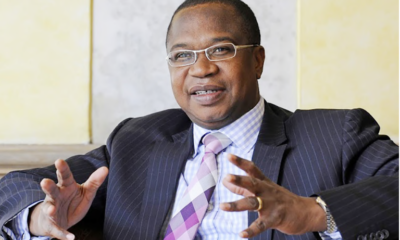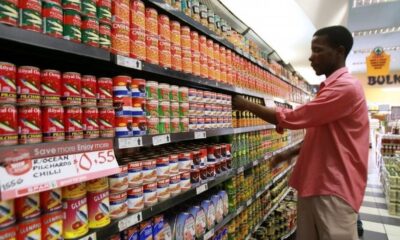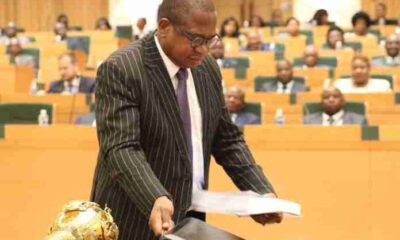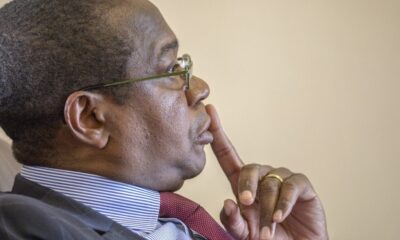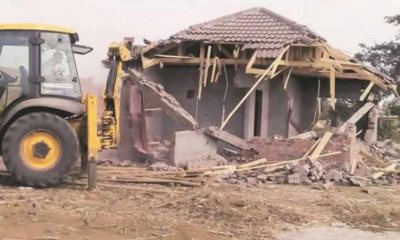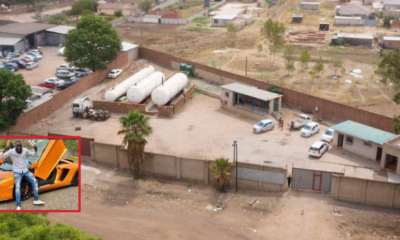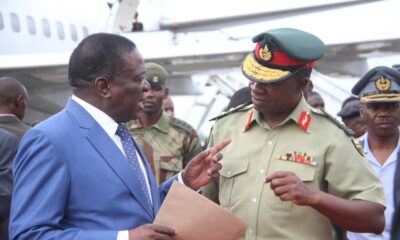
Opinion
Zim’s 2024 economic outlook: The US dollar straightjacket
Published
1 year agoon
By
NewsHawksJOHN LEGAT
IN our October Notes we made the bold assumption that “the United States (USD) would remain in place for a good while yet” and beyond the initial deadline for its usage to 2025.
Fortunately we were proven correct as the government extended the timeline to 2030. That immediately removed a great deal of uncertainty, especially within the banking sector which very quickly was comfortable to issue USD loans to its customers.
That news, together with the very tight liquidity in the Zimbabwean currency (ZWL) market, simply served to promote the more widespread use of the USD within the economy.
As we have stated before there is simply no trust with the ZWL, whilst its usage is more determined by its availability when required and the value of the transaction relative to the USD.
This is especially the case when the difference between the official and the parallel rates of exchange is as much as it is now, or nearly 100%, which makes paying for government services at the official rate appear good value.
In our recent Notes we have written on the subject of “Once Bitten, Twice Shy”. This reality makes USD cash that much more attractive than USD nostro held in a bank. The experience of the 2016-2018 period when the banks were unable to provide USD cash against USD held on deposit put paid to that. The current requirement for retailers in the formal sector to price their goods in USD close to the official exchange rate makes their products super expensive compared with direct imports and the informal sector operating close by.
Hence the Reserve Bank of Zimbabwe (RBZ) Monetary Policy Committee advised government last October to remove that trading margin requirement. That advice has yet to be heeded and so supermarket transactions have collapsed and with it VAT receipts to government.
Countries typically adopt another country’s currency when there is no longer trust in the management of their own currency. That was very much the case in Zimbabwe in 2008 when the ZWL, as it was then, became worthless as a result of hyperinflation, itself caused by the massive creation of excess ZWL by the central bank to fund government’s expenditure. The recently elected President of Argentina, Javier Milei, won the election based upon his determination to radically reform the economy which would include scrapping the Argentina peso in favour of the USD.
Unfortunately his majority was not large enough and so he has already back-tracked on that commitment even though there is little trust in the peso by the general public.
Vested interests in Argentina have too much to lose on the other hand.
This is a pity as it would restore confidence in Argentina overnight, as it did in Zimbabwe in 2009 when the government officially killed the ZWL in favour of the USD.
When the Unity Government took control of the economy in 2009 under the USD, all ZWL debts were extinguished, although hyperinflation had already ensured that domestic debt was zero.
The Finance minister at the time, Tendai Biti, quickly realised that government could only now operate under the constraint of the USD; as he put it, he could “eat what he killed” and no more.
That meant that he had to grow tax revenues to fund expenditure which of course meant providing the private sector with an enabling environment to invest and grow the economy.
Foreign investment poured in. Zimbabwe had a stable monetary system for the first time in over thirty years, there was no inflation and the economy grew rapidly from a low base. Sticking to the principle of eating what you kill, meant that government could not operate with a budget deficit so that by 2013, there was very little if any domestic debt.
The private sector by that time was also restructuring; certain businesses that had been able to survive in a hyperinflating economy, struggled in a dollarised one. Those companies that chose to invest in new and efficient plant and equipment could take advantage of rising real incomes and savings in the economy which dramatically increased demand.
Strong businesses became stronger.
The banking sector in 2009 effectively had to start from scratch since bank capital, denominated in ZWL, had been wiped out. The banks had a captive customer base though which meant that it wasn’t long before its clients were depositing USD instead of ZWL. Those dollars could be on lent.
Sadly a number of bankers were all too eager to lend those USD at high rates of interest (15%-25%) to businesses that simply could not afford those kinds of loans. Bad debts started to rise and became unsustainable for a number of banks.
Nonetheless, for the banking public, confidence grew in the banks as new products such as USD credit cards that could be used anywhere in the World, together with bank cards that could churn out USD cash from an ATM became the new normal, something that Zimbabweans at home had not enjoyed for well over forty years.
Foreign investors were able to buy listed and cheap businesses on the Zimbabwe Stock Exchange priced in US dollars; in short there was no longer a currency risk.
Further those investments could be sold and profits could easily be repatriated together with any dividends earned.
The stock exchange rose substantially as a result enabling Zimbabwe businesses to issue new shares to raise capital to invest back into their businesses.
Whilst the economy was on a sound and growing footing, the politics within the country was anything but.
Not surprising as the two main political parties had to share power; the former ruling party since 1980 was not happy with that arrangement whilst the former opposition was also not pleased having to compromise with its planned reform programme. Having adopted the USD, the RBZ no longer had a role to play other than as a regulator of the banking system.
It could no longer dish out money to politicians or those wanting some funds as it had done during the hyperinflation years when it became the centre of economic planning and control. Indeed the only means to access such funds under dollarisation were through state owned enterprises under the control of government ministries. Unfortunately this was to end badly for those companies concerned and by implication, for government further down the road.
With the change in government in 2013, the discipline of a balanced budget went out of the window. Initially the budget deficit was funded by issuing US dollar Treasury Bills (TBs), largely to banks and pension funds. This was fine but it only encouraged government to spend more of what the Ministry of Finance felt was free and unlimited USD.
By 2016, the amount of USD government debt in issue that was not backed by USD had become unsustainable; banks’ balance sheets had up to 30% in government TBs.
Civil servants’ wage accounts were being credited with electronic USD, again backed by nothing. The game was up when the RBZ announced that the era of free funds was over in December 2015. By 2016 bank depositors could no longer easily withdraw USD cash or transfer funds overseas. They were instead encouraged to use electronic dollars on their debit cards, or RTGS dollars which the RBZ insisted were one to one with a USD. That illusion also did not last long. So in a matter of three years the government and the RBZ could no longer be trusted to manage a USD economy, let alone a ZWL one.
The dawning of a new Republic in 2017 could and should have corrected these errors. In 2018 the new Minister of Finance formally broke the illusion of the RTGS dollar and the USD in October 2018 when he instructed banks to separate what were obviously USD on their balance sheets with what were clearly not, i.e. electronic nostro dollars. Then in February 2009 he introduced a whole new Zimbabwe dollar, the ZWL at ZWL2.5 to 1 USD.
Today that same currency is ZWL12 000 to 1USD.
So that initiative went well…….if the intention was to create a lack of trust in a whole new currency.
Returning to the present day, we now have a situation where the general public and foreign investors have zero trust in the management of the ZWL by the government but have full faith in a USD bank note. Once bitten twice shy, they have no faith in the banking system to look after their USD deposits or in the government who could change the monetary system at the issuance of a Statutory Instrument, as it has done before.
The government authorities therefore find themselves in more of a pickle than before. During the period 2009 to 2014 there was at least trust in the formal banking and retail sectors. As a result government could tax the population in the way that any other government would do, through income tax, VAT and corporation tax.
By doing so, it funded its expenditure which was budgeted at what it could afford.
In 2024, the formal sector is weak. The retailers cannot sell product at prices that make economic sense and so trade goes elsewhere and government receives less VAT than it should. The banks receive limited amounts of deposits relative to the size of the economy and so their balance sheets shrink in real terms. They cannot meet the private sectors’ demands for loans as they have limited liquidity. External lines of credit sought by the likes of CABS, First Capital and NMB are quickly exhausted.
Indeed, loan requests might have been approved by the bankers but drawdowns are not taking place as the banks have insufficient funds. They cannot and no longer have the appetite for holding USD TBs as the last time they did that such assets ended up being more or less worthless.
Analysing our own industry, the pensions and insurance sector, the latest statistics from Insurance and Pensions Commission (Ipec) point to a similar picture. At the official rate last September, total assets of pensions and insurance funds were valued at just US$1.9 billion; in real terms of course this number is much less. Cash at the bank, or true liquid funds, were valued at a mere US$31 million – for the entire industry.
Yet government wants them to invest in infrastructure development or buy more prescribed assets! 55% of pension fund assets were invested at that time in illiquid property and a further 8% in largely illiquid prescribed assets.
Only 21% were invested in equities being one of the few liquid assets; this is a very low percentage by historical standards. Within that equities asset class there is Old Mutual and PPC which remain untradeable and therefore dead assets-implying an even lower value of actual liquid assets.
Meanwhile, Ipec wants the pension funds to compensate pensioners for the loss of value back in 2009. One wonders with what exactly. Sell Delta shares where the ZSE currently values the entire company at a mere US$500 million perhaps to raise liquidity? This makes no sense to those currently contributing to their pensions each month.
Given that the formal sector is weak and diminishing relative to the economy as a whole, tax revenue in relative terms should also be falling. That should imply that government should reduce its expenditure to take that into account. The December budget expanded expenditure by our estimates although it is hard to tell as their budget was presented in ZWL despite the fact that the economy is likely over 70% dollarised.
The 2023 original budget released in December 2022 was for expenditure in 2023 of ZWL4.5 trillion but the forecast at the end of the year had grown to ZWL22.6 trillion. Taking the auction exchange rate at these times, the original budget was for expenditure of US$6.9 billion.
The 2024 budget is for expenditure of US$10 billion; hardly a reduction in spending. Indeed the entire budget presentation gave the impression of desperation or a clutching at straws as government attempts to fund itself with the introduction of a myriad of new taxes.
Further a number of the new taxes have already been reduced – or even removed – by the Minister of Finance during the first week of the New Year!
Meanwhile, the economy would appear to be growing just fine albeit now driven by the informal sector that operates largely in USD cash. We should soon start to hear from companies about the final quarter’s sales in 2023 which will give us an idea as to how the economy is performing, or at least the informal economy. If it continues to grow as we expect, then the formal sector and the government sector will by definition continue to shrink as a percentage of the whole economy. Should that trend continue we may well see further casualties in the formal retail sector as we began to witness in 2023.
Adopting the USD dollar as a currency, or for that matter some other country’s currency, in effect acts as a straightjacket on government by ensuring that it manages its books accordingly and then over time it can gain the trust of its people and international participants as a good conductor of economic policy at which point it can attempt to borrow both domestically and internationally.
This was happening in the 2009 to 2013 period. Unfortunately all trust was destroyed from 2014 onwards when the government of the day tried to create its own USD to fund excessive spending, through the massive issuance of USD TBs which it could not honour or through the creation of electronic US dollars.
That has huge implications in 2024 as the straight jacket of dollarisation is now that much tighter than it ever was in 2013 to the extent that the government will find it far harder to fund its expenditure through local means such as taxation. The damage done to its reputation back in the 2014-2019 era by effectively converting depositors real USD, first into RTGS and then into ZWL, will linger for many years to come. Its handling of the ZWL since 2019 simply makes the situation even worse which explains why today USD cash is king.
The economic authorities therefore find themselves in a bind of their own making. Some commentators therefore suggest that the USD should be banned again in favour of the ZWL, but as we saw in June 2019, the economy would collapse since there is zero trust in the management of the ZWL which is not surprising.
Others have suggested a currency board by permanently pegging the ZWL to another currency, which could be the USD. There again, the lack in trust in Government authorities would imply that the management of the currency board could only practically be undertaken by an external party who would manage the system under strict rules. The RBZ would need to be abolished by law to remove any risks to the monetary system. We doubt government would go down this route, at least for the time being.
We would opine that government would be better off making life easier for the formal sector, especially retail, so that at least it has a chance to survive and hence pay its taxes. Increasing VAT simply drives more trade to the informal sector. Government’s aim should therefore be to level the playing field with the informal sector rather than punish the formal one. Asking local manufacturers to cease trading with the informal sector as the budget suggests, will simply persuade the informal sector to source from the region. Local manufactures will therefore suffer as will government’s tax revenue.
Taxing sugar used in beverages will simply make local drinks more expensive compared to the same products available in the region. The informal sector will therefore buy there and not at home.
One of the best ways to tax the informal sector is to increase fuel duties which will impact the entire economy; it is an important source of income for the UK government for example. Should they do so, it must be complimented with a reduction in taxes for the formal sector as a means to compensate and help to level the playing field. Whatever they do, one cannot help feeling that the government sector should shrink as a proportion of the economy and become less relevant.
An analogy of this might be to look at the situation of a company operating on the ground. Let’s assume that the company is operating in road building and other infrastructure works.
Two years ago 65% of its business was to government, but more recently, since government does not have the ability anymore to pay for the works that it requires and indeed might be owing sums for works already done, then the company instead diverts its equipment to other projects, such as housing infrastructure or to roads contracts in the region, which are wholly independent of the Zimbabwe government.
Over time government becomes less relevant to its overall business and its operations.
Escalate that to the entire economy, over time the government becomes less relevant whilst the private sector becomes the driver. Far from being a negative this should perhaps be viewed as a positive in our lives!
The International Monetary Fund (IMF) will complete its Article IV report on Zimbabwe in February following the team’s visit in October. They have been highly critical of the RBZ’s quasi-fiscal operations (QFOs) which we ‘guesstimate’ at around 3% of GDP per annum and which the IMF believe – and we would agree – undermines the ZWL.
In layman’s terms, QFOs are used by the RBZ to fund Government expenditure or debt repayments to the likes of Afreximbank by creating ZWL in order to purchase USD to make the payments.
The Ministry of Finance has since taken control of such expenses by bringing them into the formal budget so that ZWL is not created for such purposes by the RBZ. QFOs were used extensively pre-2009 and ultimately led to Zimbabwe’s hyperinflation. Unfortunately when tax revenues are in short supply but pressing payments need to be made, QFOs tend to be the easiest way out of the problem. In the 2014-2018 era, the answer was to issue USD TBs or create electronic USDs. Those options can no longer be used as everyone is wise to that; once bitten, twice shy.
The government’s only long term solution, in the face of declining tax revenues is to cut its expenditure (‘eat what you kill’) but the 2024 budget showed little evidence of that.
We therefore cannot help feeling that QFOs will continue which could explain the ZWL’s recent move from ZWL9,000 to ZWL12,000. That said Zimbabwe will have a new governor from May this year so it will be interesting to understand his views on QFOs going forwards.
Hopefully it will be aligned to those of the IMF.
As the IMF has pointed out, the QFOs not only undermine the currency but also add to foreign debt which occurs when the government takes on the RBZ’s debts, something that happens all too regularly and was done again in 2023 (a whopping US$1.8 billion).
Since the August elections there has been little action with regard the debt reduction talks that were being led by the former President of Mozambique and the African Development Bank, although the Ministry of Finance is hopeful that these will recommence this month.
The IMF though is happy to sponsor a credible Staff Monitored Programme (SMP) which would be a step in the right direction and their team will soon be visiting the country to continue that process.
Contrary to the budget statement, an SMP does not provide USD funding but only provides for technical advice to the country.
The Debt Bulletin released at the same time as the 2024 budget provides interesting reading and is a commendable document.
Zimbabwe’s total public (and publicly guaranteed) debt or PPG, stood at US$17.5 billion of which US$12.7 billion was external debt. (In 2008 it was roughly US$6 billion).
Of that external debt, China accounts for US$2 billion, and drilling down further, US$1 billion relates to the new Hwange 7 and 8 power plants with a further US$200 million for the expansion and upgrade of RGM International Airport. These loans were provided by China Exim Bank.
A further US$375 million was to be disbursed by this bank for Hwange 7/8 by year end 2023. In the nine months to the end of September, Zimbabwe paid a total of just US$55 million to all of its external creditors, of which US$8 million was to China Exim Bank. This seems a very small amount on a loan of that size notwithstanding that we do not know the terms of the loan.
Further in 2023, Zimbabwe took on a new loan of US$400 million from Afreximbank at a rate of over 11% payable monthly, but backed by 35% of Zimplats export proceeds which are controlled by the RBZ. This is very expensive debt.
This loan was for budget support. It would appear to us that Zimbabwe is not in a position to take on any more external loans, as it is clearly finding it very difficult to service even the newer debts taken on over the past five years. Despite this the budget is looking for further external loans of US$370 million in 2024.
Of the US$12.7 billion in total external PPG debt, US$3.6 billion are from the RBZ.
Drilling down into these there are loans for US$1.9 billion from “regional multilateral banks”. It doesn’t state who these banks are, but we would hazard a guess at Afreximbank again, and maybe some South African and other regional trade banks.
The Ministry of Finance has taken on US$1.8 billion of these debts onto their books in 2023. The budget has allocated US$338 million to service this debt in 2024 of which US$80 million is interest. The bottom-line in our view is that government can ill-afford to run a budget deficit going forwards and should return to cash budgeting or “eat what you kill.”
Of further interest to us in the debt report was the concept of “asset recycling” which would be undertaken with Africa50, a business that was established by the African Development Bank. The idea would be that initially government would “hand over” to Africa50 the three main airports in Zimbabwe and maybe the Harare/Beitbridge highway, in return for funds that could then be recycled into other infrastructure projects. This is a fascinating concept and one that we will keep a close eye on.
Looking at the financial markets in Zimbabwe, the Zimbabwe Stock Exchange (ZSE) and the Victoria Falls Stock Exchange (VFEX) remain extremely cheap from a valuation and a dividend yield perspective.
Although the ZSE rose by 956% in ZWL over 2023, at the black market rate it fell by 11%. The VFEX had a terrible first year with the index falling by a whopping 29% in USD terms. We suspect that the real reason for rebasing the VFEX index to 100 at the end of 2023, was an attempt to sweep those losses under the carpet! Foreign investors were not attracted to the market as the ZSE had hoped which is not surprising given the debacle with their holdings in Old Mutual.
On the other hand, local investors were delighted to sell their shares that moved to the VFEX from the ZSE as a means to cash in with US dollars!
We remain concerned for businesses in the retail sector given our concerns raised above with regard the un-level playing field that government has unintentionally engineered between the formal and informal sectors. Those businesses supplying the informal sector should continue to do better, notwithstanding the regulations regarding selling to informal traders.
The current market valuation for the whole of Delta is a mere US$500 million, with an estimated annual dividend yield of 6% payable in USD. It should have a fantastic second half-year to end March 2024 given the new capacity that it installed in 2023.
Both Simbisa and Innscor have also boosted their capacity to meet demand which should be reflected when they report their interim numbers to the end of December. As a result of strong USD cash generation, most corporates have been able to carry out extensive capital expenditures to either refresh or expand capacities in recent years.
We are beginning to see the benefits of these initiatives as companies are now able to reduce costs and record improved efficiencies.
Unfortunately due to a liquidity squeeze and other structural issues in the economy, their stock prices are not reflecting these ‘new’ businesses and are trading at historic lows. Frustratingly there is little surplus liquidity available to take advantage of such opportunities with foreign investors staying well clear of Zimbabwe and local investors – as the Ipec numbers show – having little ammunition available. The companies themselves might be wise therefore to undertake share buybacks in 2024. This should further enhance value to shareholders.
Globally, a recession looms in both Europe and the United States, whilst China’s growth is subdued. Commodity prices may well remain under pressure including platinum and for that matter lithium. Lithium prices are down by 80% from their peak 12 months ago so don’t hold your breath that Zimbabwe’s “new gold” will help us out!
Gold on the other hand should continue to hold up as a store of value.
We wish all of our clients and readers a happy and prosperous 2024!
About the writer: John Legat is Imara Asset Management (Zimbabwe) chief executive.
You may like

